This Snail Goes Fishing With a Net Made of Slime
Go clamber around the tide pools at Asilomar State Beach this summer and you might notice something odd: Some of the rocks look like someone haphazardly glued twisty scraps of old macaroni to them. Nature enrolled in a kindergarten art class, you might think.
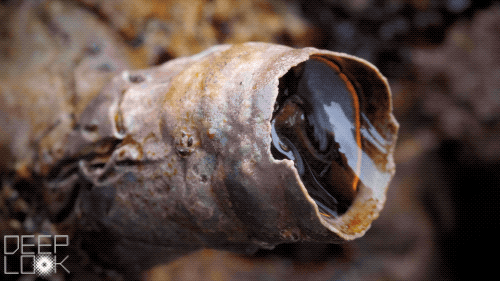
But if you watch one of those noodle-like tubes closely, after a few seconds a squishy, speckled, black-and-orange creature may peep out from the opening. You’ve just found a scaled wormsnail — a curious marine animal that built this tube out of calcium carbonate secreted from its body.
It might look tiny and fragile, but looks can deceive: As climate change fuels marine heat waves that threaten countless ocean species, this odd little mollusk could prove to be a survivor. Its strength may stem, at least in part, from an adaptable diet of marine detritus, which it plucks from the current with a net made of its own mucus.
A Fishing Net ‘Like Snot in Seawater’
The scaled wormsnail is a snail, not a worm. It gets its confounding name because it resembles marine worms that also live in tubes. But while other snails carry their houses around on their backs, this one doesn’t move at all. It anchors itself to a rock and never leaves, its tube home protecting it from the crashing surf.
The wormsnail’s cloistered lifestyle brings with it a major drawback, though.
“It can’t do the normal thing other gastropods would do, which is crawl around and search for food,” says Peter Macht, aquarium curator at the Seymour Marine Discovery Center at UC Santa Cruz.
So how can it find anything to eat?
In a process that Macht sees every day at the Seymour Center’s aquarium, wormsnails fish for their dinner by casting a net. But instead of fashioning it from rope or thread like human fishers, they use something all snails have plenty of: mucus.
“It’s going to look like snot in seawater,” Macht says.
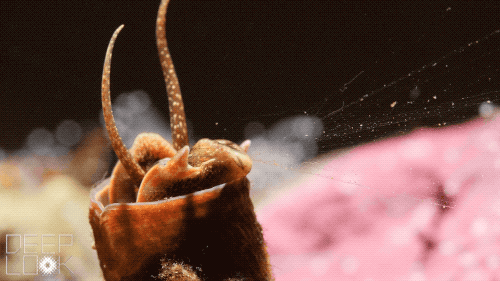
The snail releases mucus from a gland just below its mouth. But, unlike its more mobile relatives, which leave a trail of the slimy substance, the wormsnail sends mucus down the tentacles on either side of its head, forming it into strings like some invertebrate Spiderman slinging a web. The mucus strands ride the tides, spreading out into the water to create a miniature fishing net. It can cover more than 7 square inches in a matter of minutes, an impressive feat for a snail living in a tube the width of a pencil.
Reeling in the Catch With a Monstrous Mouth
Once it casts its net, the snail simply sits and waits for goodies to drift by and get caught — a tiny crustacean here, a savory mote of algae there. As it gathers particles, the net gradually becomes visible to the human eye, like a fresh spiderweb gathering dust. And by snatching random organic detritus from the water, the snail acts as a recycler, similar to a hungry earthworm breaking down meal scraps.
When it’s time to eat, the wormsnail uses its radula — an undulating conveyor belt of jagged teeth — to snag and pull the mucus net down the hatch. Seen up close, a feeding wormsnail looks a bit like the Sarlacc, the tentacled desert monster from “Return of the Jedi,” as it drags struggling prey down its gaping maw.
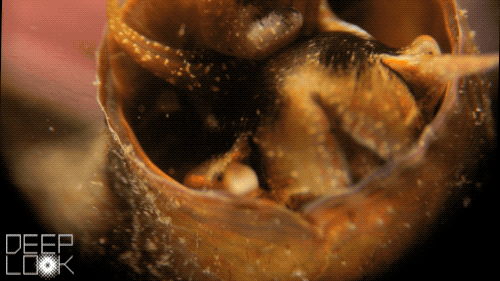
With no way of disentangling its catch from the net, the wormsnail swallows the entire bundle, mucus and all. This way, it recoups the calories it spent to make the net in the first place.
But a wormsnail has to stay alert if it wants to keep all that phlegmy goodness for itself.
“Often, their mucus nets fuse,” says biologist Michael Hadfield, who has studied wormsnails extensively at the University of Hawai’i at Manoa. “When one of them starts to pull it in, the others sense it, and they all pull in to make sure they get their share.”
Scourge of the Aquarium
In the Indian and Pacific oceans, the scaled wormsnail’s cousins antagonize other creatures, too. Tropical species of wormsnail sometimes coat corals with their mucus nets, making it harder for those corals to grow and survive. Researchers aren’t sure why, but some suggest wormsnails’ nets hog food particles or alter the balance of chemicals around the surfaces of corals.
“There’s always this death zone around the vermetids,” says Rüdiger Bieler of Chicago’s Field Museum, referring to the name given to the family of wormsnail species around the world. This can make them a pest to saltwater aquarium keepers.
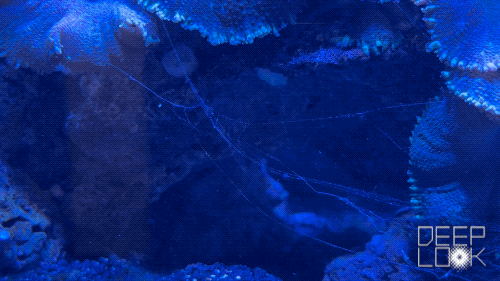
“I’ve talked to a lot of aquarium folks,” Bieler says, “and it took me a while to realize how much they hate these things.”
In Warming Waters, a Varied Menu Goes a Long Way
Along the California coast, the scaled wormsnail may be gaining a competitive advantage over its neighbors, as climate change heats up ocean habitats.
Biologists at UC Santa Barbara found that the 2014-15 marine heat wave known as the “Blob” gave a boost to scaled wormsnails living along the coast near the university’s campus. By contrast, invertebrates like sea stars, which eat wormsnails, perished during the event.
“That freed up a lot of space that the wormsnail could colonize,” says marine ecologist Bob Miller, senior author on the 2022 study.
As a result, wormsnails spread to occupy over 80 times more space than before the Blob — from less than one-fifth of a square foot at each study site to over 16 square feet per site, on average.
Miller believes the scaled wormsnail may be able to withstand heat waves along the California coast because it has evolved within a range that extends south to Baja California, Mexico, where waters are already warmer to begin with.
Not being a picky eater may help, too, the researchers noted. When a heat wave makes nutritious plankton hard to come by, for instance, shreds of kelp and other floating food bits can fill the snails’ phlegmy nets instead.
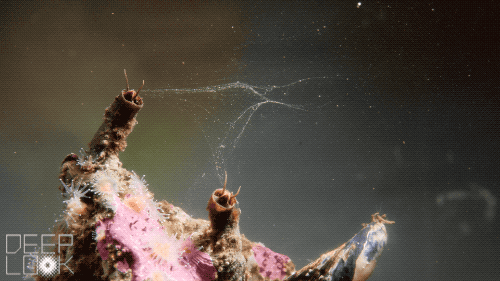
Whatever may end up in their nets, wormsnails will continue to perform an important job: As their nets filter the water, they keep coastal habitats clean for everyone.
“They’re doing their part in recycling dead plant material,” biologist Hadfield says. “If there were no recyclers except bacteria and fungi in the sea, there would be huge piles of decaying detritus.” Those piles would suck oxygen from the environment as they decomposed, potentially harming other marine animals.
So next time you’re exploring the tide pools, peering through clean, clear water at anemones, crabs and nudibranchs, just remember — among many other creatures, you’ve got a sedentary little snail and its mucus to thank.
